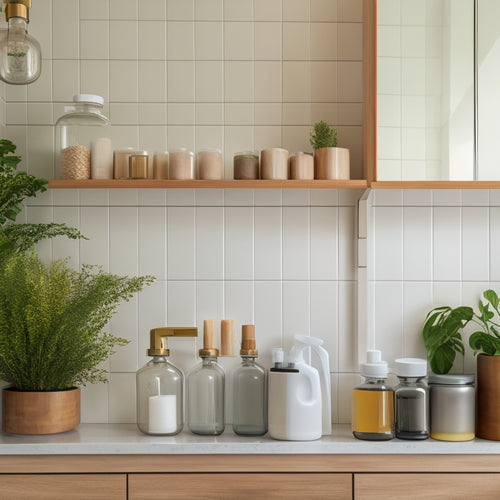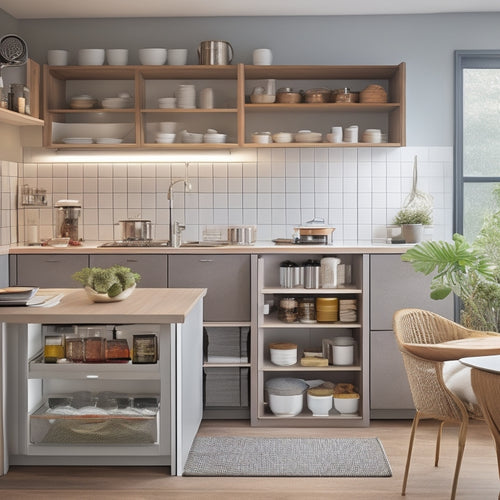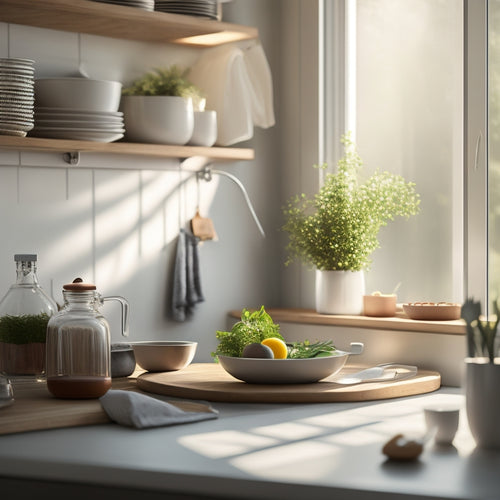
Revamp Your Pantry: Free Canning Inventory Printable
Share
You're about to transform your pantry into a canning haven, where every jar has its designated spot, and you can easily track your inventory with our free printable template. Start by purging unnecessary or expired items, then assign designated space for each type of canned good. Use clear jars, label them, and arrange them by type and date. Creating a canning inventory will help you track what you have on hand, plan meals, and reduce food waste. With our template, you'll be able to list canned items with quantities and dates canned, and group them by type for easy meal planning. Next, get ready to optimize your pantry's storage space.
Key Takeaways
• Use a canning inventory printable to track your canned goods, including quantities and dates, to ensure you know what you have on hand.
• Organize your inventory by grouping similar items together, making meal planning and grocery shopping more efficient.
• Update your inventory regularly to maintain accuracy and prevent spoilage of expired or unused items.
• Assign a designated space in your pantry for each type of canned good, making it easier to locate items and reducing clutter.
• Create a system for labeling and dating jars, ensuring you use the oldest items first and reducing food waste.
Benefits of Pantry Organization
By organizing your canning pantry, you'll access a multitude of benefits that can transform your kitchen experience, including maximizing storage space, preventing spoilage of canned goods, and making it easier to locate items.
You'll be able to fit more jars in a smaller area, reducing clutter and mess. This, in turn, will prevent spoilage, saving you money and ensuring your hard work doesn't go to waste.
Additionally, an organized pantry enhances efficiency, promoting safety by reducing the risk of accidents caused by clutter or expired goods. With everything in its place, you'll spend less time searching for ingredients and more time enjoying the fruits of your labor.
Organizing Your Canning Pantry
To optimize your canning pantry, start by purging any unnecessary or expired items, then assign a designated space for each type of canned good, ensuring everything has a clear and accessible home. This will help you maximize space and create easy visibility.
Use clear jars and label them with contents and canning dates to make it easy to identify what you have. Arrange jars by type and date, with older items rotated to the front. Consider using tall, shallow pantries or small space pantry organization ideas to make the most of your storage.
Creating a Canning Inventory
You've optimized your canning pantry, now it's time to create a system to track your inventory, making sure you always know what you have on hand and when it was canned.
Effective canning inventory tracking is essential for maintaining a well-organized pantry. Start by listing all your canned items, noting quantities and dates canned. Group items by type, such as fruits or vegetables, to simplify meal planning.
Update your inventory regularly to make sure accuracy. Consider using a printable template, like the one provided, to streamline the process. Keep the printable near your pantry for easy access and reference.
Storage Ideas for Jars
Store your empty jars in durable containers with cardboard separators, keeping them organized and protected from dust and damage. This jar organization method ensures they're securely stored for future use. Consider placing these containers in untouched areas like basements or closets.
Use lidded containers to prevent dust buildup and keep your jars clean. For canned goods, stack them with rims removed and cardboard layers to maximize storage space. This canning storage technique allows you to store more jars while maintaining visibility and accessibility.
Canning for Food Preservation
By preserving your own food through canning, you're not only saving money but also ensuring a steady supply of nutritious food throughout the year, no matter the season.
This is especially beneficial during winter when fresh produce is scarce and expensive. By canning your own food, you can enjoy winter savings and have a steady supply of your favorite fruits and vegetables.
Explore canning recipes online and start preserving your own food today. With a well-stocked pantry, you'll be able to plan meals around your canned goods, reducing food waste and saving you money in the long run.
Frequently Asked Questions
How Often Should I Clean and Sanitize My Canning Pantry?
You should clean and sanitize your canning pantry every 1-2 months, using a mixture of soap and hot water, and then sanitizing with a solution of 1 tablespoon of unscented bleach per gallon of water, ensuring minimal sunlight exposure.
Can I Store Canned Goods in a Pantry With Direct Sunlight?
"Oh, you think direct sunlight in your pantry is a great idea? Think again! Sunlight exposure can cause canned goods to degrade, so store them in a cool, dark place to maintain their quality and shelf life."
How Do I Handle Expired or Spoiled Canned Goods?
You handle expired or spoiled canned goods by checking for signs of spoilage like rust, dents, or swelling, then disposing of them safely, following canning safety guidelines to avoid foodborne illnesses.
Is It Necessary to Use a Pressure Canner for All Canning Projects?
'As you start on your canning journey, don't be intimidated by the pressure canner myth - you can achieve safe, delicious results with water bath or steam canning, exploring alternative methods that suit your needs and skill level.'
Can I Customize the Printable Inventory to Fit My Specific Canning Needs?
You can tailor the printable inventory to fit your unique canning needs by exploring customization options, such as different formats, to make sure it suits your pantry's specific layout and organizational style.
Related Posts
-

Under-Sink Storage Tips for Minimalist Kitchens
To maximize under-sink storage in your minimalist kitchen, start by utilizing vertical space with shelf risers and st...
-

Space-Saving Kitchen Solutions for Busy Homeowners
To maximize your kitchen's potential, start with vertical storage solutions like wall-mounted shelves and pegboards f...
-

Space-Efficient Dish Racks for Tiny Homes
Space-efficient dish racks are a game changer for tiny homes. By utilizing vertical storage, you can free up signific...


